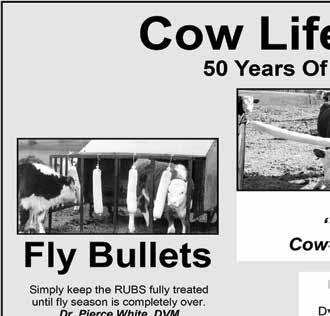
6 minute read
Don’t Expect Things To Return To The Way They Used To Be
Jeff Lehmkuhler PhD, PAS
With increasing land values (see Figure 1), beef producers looking to enter or expand operations are faced with challenges to pencil a profitable return per acre when land cost is included. Over the last couple decades, years of high grain prices pulled marginal forage/ pasture acres away from forage production as rental rates offered were higher from grain producers than grazers. Thus, less forage acreage available for livestock forage production kicks in the macroeconomics functions of supply and demand leading to higher rental rates or challenges to find land available to rent near the home base of the cattle operation. As an example, the average rental cost per month for a cow-calf pair in Nebraska was estimated to be $57.64 compared to $25.70 in 2007-2008 (E. Dennis,
2022). Of course, urban sprawl is another leading driver of increased land value and housing developments continue to increase in many rural areas (Figure 2).
Many “land and cattle” operations recognize the land holding as an appreciating asset over time. The land asset is considered a long term payback to the operation. Land charges should be doled out to each agricultural enterprise to cover the land investment with these charges included in the enterprise budgets. Along with this appreciating land value comes increased tax payments which should be considered in the land charge. However, consider this question “Can the land value appreciation offset a slight loss in the beef operation?”.
Granted, I am not an economist by any means.
Yet, in my discussions with producers, I hear many of their concerns about production costs increasing. Many ask when will inputs come back down with an underlying expectation that they likely will not return to where prices were 10-20 years ago. Beef producers mention they need the current high feeder cattle prices to make a profit, which I am not arguing. However, I don’t know that many of our producers complete an annual enterprise budget for their operations to make decisions. We could take this one step further and ask ”What is the return per acre from the beef enterprise?”. I have been in this field long enough to know the reasons why budgets are not done, but this doesn’t mean we should not consider looking at the financial aspects of the operation to help plan for future decisions. Take the time to manage the nancial aspects of the farm and do your business plan. What are your business strengths and weaknesses? If you don’t know, consider a SWOT analyses to identify your operation’s Strengths, Weaknesses, Opportunities, and reats. De ne your marketable product and identify your marketing plan to capture the greatest return. Document your beef herd production, inputs, and receipts so you can analyze these each year. As Dr. Anderson wrote recently, it is perfectly ne to like cows and make money from the operation. Farmers are faced with making many choices. Farming would be easier if there was no limit on spending, but this is not the case. I like to teach the challenge of management as presented by Dr.
Tom Fields using interconnecting circles (Figure 3). Nearly everything in a farm system overlaps. When we decide to purchase a replacement bull, these funds are no longer able to be used on infrastructure, forage improvement, herd health, mineral supplements, etc. When nancial resources are limited, we have less money for hired labor, custom harvesting, preventative herd health, and other items. e question becomes when nances are tight is this impacting our quality of life and enjoyment from farming? Personally, I believe that if we can make these decisions based on information using logical approach having considered the enterprise budget, cost/bene t analyses, and/or pros/cons list then there is no need in the future to dwell on whether the decision was right or wrong. Every farming operation is guided by a di erent set of goals and available resources. What works for one farm may not work for another. Feeder cattle prices are going to move up and down with lean years and some pro table years. Consider the opportunity to assess your operation and make wise investments that have the potential to improve your bottom line. Most importantly, do not dwell on decisions made in the past nor ponder when will things return to the way they used to be. Enjoy the memories of the past and use the knowledge gained to build for a successful future.
Spring-Calving Cow Herd
• Observe spring-calving cows closely. Check cows at least twice daily and first-calf heifers more frequently than that. Be ready to assist those not making progress after 1 to 2 hours of hard labor. Chilled calves should be dried and warmed as soon as possible.
• See that each calf gets colostrum within an hour of birth or administer colostrum (or a commercial colostrum replacement) with an esophageal feeder, if needed.
• Identify calves with eartags and/or tattoos while calves are young and easy to handle and record birthdate and Dam ID. Commercial male calves should be castrated and implanted as soon as possible. Registered calves should be weighed in the first 24 hours.
• Separate cows that have calved and increase their feed. Energy supplementation to cows receiving hay is necessary to prepare them for rebreeding. For example, a 1250 lb cow giving 25 lb/day of milk would need about 25 lb of fescue hay and 5 lb of concentrate daily to maintain condition. If you need to go from a condition score of 4 to 5, you will need to add about 2 more lb of concentrate. Cows must be in good condition to conceive early in the upcoming breeding season.
• Watch for calf scours! If scours become a problem, move cows that have not calved to a clean pasture. Be prepared to give fluids to scouring calves that become dehydrated. Consult your veterinarian for advice and send fecal samples to diagnostic lab to determine which drug therapy will be most effective. Try to avoid feeding hay in excessively muddy areas to avoid contamination of the dams’ udders.
• Continue grass tetany prevention. Be sure that the mineral mix contains high levels (~15%) of magnesium and that cows consume adequate amounts. You can feed the UK Beef IRM High Magnesium mineral.
• Plan to vaccinate calves for clostridial diseases (Blackleg, Malignant Edema) as soon as possible. You might choose to do this at the prebreeding working in late April or early May.
• Obtain yearling measurements on bulls and heifers this month (weight, height, pelvic area, scrotal circumference, ultrasound data, etc.) if needed for special sales. Heifers should be on target to be cycling by the start of the breeding season.
• Prepare bulls for the breeding season. Increase feed if necessary to have bulls in adequate condition for breeding. Obtain Breeding Soundness Evaluation (BSE) on bulls, even if they were checked last breeding season. Only use bulls that pass the BSE.
• Finalize plans for your spring breeding program. Purchase new bulls at least 30 days before the breeding. Order semen now, if using artificial insemination
Fall-Calving Cow Herd
• Bull(s) should be away from the cows now!
• Plan to pregnancy check cows soon. You can also blood test for pregnancy as early as 30 days after bull removal.
• Creep feed calves with grain, by-products, or high-quality forage. Calves will not make satisfactory gains on the dam’s milk alone after about 4 mos. of age – since there isn’t much pasture in March, fall calves need supplemental nutrition. Consider creep grazing on wheat pasture, if available. Calves can also be early weaned. Be sure that feed bunks are low enough that calves can eat with the cows.
• Calves intended for feeders should be implanted.
• Consider adding weight and selling your fall calves as “heavy” feeder calves. Keep them gaining!
General
• Repair fences, equipment, and handling facilities.
• If you have a dry, sunny day, use chain-link harrow to spread manure in areas where cattle have overwintered. This may be done in conjunction with renovation.
• Renovation and fertilization of pastures should be completed.
• Start thistle control. They can be a severe problem in Kentucky pastures. Chemical control must be done early to be effective.
• Watch for lice and treat if needed.
5,483 cows harvested 2,357,308 pounds of ground beef packaged $4,928,108.13 farm gate sales

351 farms impacted 76 counties impacted in 180 Kroger stores www.kentuckycattlemensbeef.com
Also available at the KFC Yum Center, Kentucky Fair & Expo Center, Louisville Slugger Field, and Wild Health Field.












